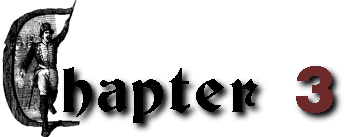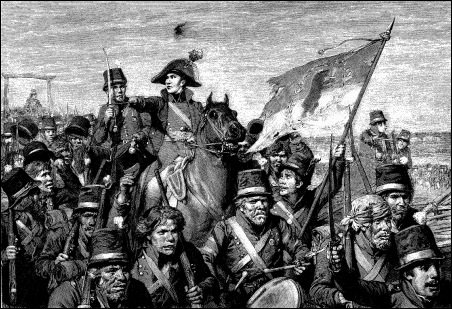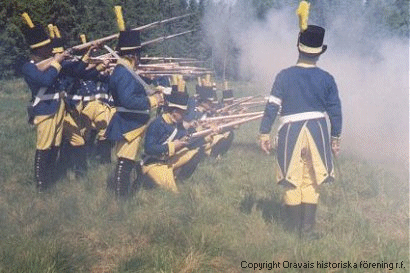
The summer campaign 1808
While the engagements in the north had ended the Swedish retreat and instead forced the Russian armies to retreat south to Kokkola (Gamlakarleby), the Swedish forces stood still in Brahestad. The supply lines back had to be secured and the offensive could not begin until the middle of June. The first unit to break up and start offensive warfare, was Sandels' Fifth Brigade that went south east, into Savolax in the direction of Kuopio. These vicinities were almost empty of Russian troops and after winning a skirmish against a Russian unit under Obuhov at Pulkkila on May 2, Sandels could retake Kuopio. He then continued with his 1.400 men all the way forward to the Russian border. This worried the Russian commanders who immediately asked for reinforcements and an army of 8.000 men reinforcements was set up under Barclay de Tolly to fight Sandels in the eastern areas of Finland. Although the Russians were overwhelming in numbers Sandels entrenched himself at Toivala and there held the Russians at bay although they attacked on an almost daily basis, until late September. Sandels' offensive was one of the most remarkable operations of the entire war. The experienced general Sandels took Russian depots, constantly harassed their back and committed actions that won him respect among both friends and foes. In the meantime, on secondary theatres of war, the Russians had been operating against both the Åland islands as well as having Gotland under occupation for a short while.

While all this was happening in the east, the main Swedish army started to move, although the promised reinforcements from Sweden had been insufficient, beginning the summer offensive on June 16. On June 24, the Russian army was near of being surrounded inside the town of Nykarleby and at the same time Swedish reinforcements finally arrived at Vasa. Heavy streetfighting inside the town of Vasa followed between the opposing armies, but as the Swedish expedition did not receive any help from the troops in Nykarleby, they soon found themselves retreating. One of the results of the Vasa-expedition was that the peasants rose against the Russian occupation in southern Österbotten but they were brutally suppressed.
The Swedish offensive continued without mercy and on July 14, the main armies met at Lappo in central Österbotten. The following battle could have been decisive if Adlercreutz had used his position correctly. The Russian commander, Rayevskij, had about 4.100 troops at his disposal and the Swedes could show 4.700. Rayevskijs bad defensive positions suggested that the Swedes should try to cut off the retreat for the Russian troops, thereby surrounding their main army. Adlercreutz did not deal with the situation correctly though and tried to attack both flanks of the Russian army at once. The Björneborg regiment, under the legendary general Georg Carl von Döbeln, had already gone out in the fields when they were held back by Adlercreutz. Irritated by the fire from the Russian lines, Döbeln went on the attack shortly before Adlercreutz had given the order though and at this moment one of the more famous episodes of the war took place. The Björneborg regiment was let loose over Lappo as it went to ferocious attack, with flying banners, against the Russians therein. Russian skirmishers lay in the field outside the village, and inside, Russian formations stood waiting for the coming onslaught. Döbeln and his regiment cleared the village of all opposition. The battle came to a close as Rayevskij retreated and the Swedes could only regret that he had escaped their trap.
After the victory at Lappo, Adlercreutz now pushed his lines forward. Near Kauhajoki, the only important cavalry skirmish during the summer campaign was fought. A patrol of Russian hussars were attacked and thrown back by dragoons of the Nyland dragoon regiment.
At this point in the war the situation was desperate for the Russians. Russian reinforcements were arriving steadily though. The commander of the main Russian army, Rayevskij, had to step down after the defeat at Lappo, and was exchanged by the young and brilliant Nikolai Michailovitsch Kamenskij, who had become major general at the age of 23 and now had come to Finland to participate in the campaign. He now took command on July 24. For the time being the Swedish continued their war of reconquest with success though. On August 10, Döbeln sealed a victory at Kauhajoki against Schepeljeff after a decisive and corageous attack, and on August 17, Adlercreutz, with 3.800 troops, fought 2.400 Russians under colonel Erikson with success at Alavo. On August 28, Swedish general von Otter defeated a Russian force at Nummijärvi.
Although these initial setbacks, Kamenskij started his counteroffensive with about 21.200 troops, while the Swedish army at this time counted 11.600 troops. The time had come for the decisive moment.
The Russians started their attack and on August 21 the Swedes under von Fieandt were defeated at Karstula. The following actions were to take part further west, along the coast. The battle of Lappfjärd on August 29 ended in a Russian victory. On the main front, further inland, Adlercreutz stood against Kamenskij in bitter fighting at Ruona and Salmi (where the most violent artillery duel of the entire war was fought) on September 1-2, where Adlercreutz was finally beaten. Retreating was the only way out for the Swedish and they went north, to Vasa, to collect their troops and plan for the coming warfare. The turningpoint had arrived.
The decisive battle of Oravais and its aftermath
The Swedish army retreated further north with its tail between its legs. At Nykarleby the army was threatened to be cut off in its retreat as Russian detachements were operating in that direction, therefore general Georg Carl von Döbeln was sent to the important crossroads at Juthas to protect the road north for the Swedish main army. On September 13 he won a victory over Russian troops under Kossatchoffskij and this battle of Juthas has reached legendary status in Finnish and Swedish history as it was related to with shining words in Fänrik Ståls Sägner (freely translated):
"Along the lines cries were soon heard:
'forward, forward, on to victory or death!'
Like a thunder was the voice of Standar
and old Nord beat the drum as it was heard,
and the young one with his belly blown up
went on over the field, with his blood running,
and in the front rode Döbeln himself with sword in hand,
and before the evening's shadows fell
was the Russian force thrown over
and saved was Adlercreutz' free journey."
The day dawned clear and beautiful. Birds were singing in the deep woods as the sun shed its first light on the lush landscape. Down from the sea came a light wind in which the trees waved silently in early greeting as the 14th of September dawned. And Adlercreutz had chosen his position. From a nearby hill he stood watching as his troops formed on the fields below, he saw the colourful uniforms; swords and bayonets shining in the early morning light, he heard the noice of the voices and the rattle of the weapons. He had chosen good positions for the coming defensive battle, and that was what he had planned - to keep the Russians at bay for some time. He did not want the decisive engagement. As Adlercreutz stood watching the Swedish army form up, Russian commander Kamenskij was alread on his way to meet him with a considerable force. The dawning day, September 14, 1808, would bring surprises for both Finland and Sweden. The destiny of the 600-years old Swedish-Finnish union was to be decided.
While the battle of Oravais of September 14, 1808 was no large battle by continental standards, it surely made its mark in Finnish and Swedish history. The main armies were to fight a decisive battle that would decide the future of Finland. Adlercreutz had about 5.500 troops present and while the number of artillery has not been established, it should mount up to 18 guns. The Russians came in with about 6.000 soldiers, also counting the cavalry. The battle was fought on the fields and in the woods just south of the village of Oravais and the Swedish line of defence stretched along the slight heightening in the landscape that ran alongside the rather insignificant river of Fjällån. The Swedish avantgarde was placed at the bridge at Lillträsket and it was here that the first shots in the battle would be traded.
The battle at the Swedish outpost began about five in the morning as the Russian avantgardes under Kulnev arrived. The initial fight at the outpost continued for several hours, draining resources on both sides. Adlercreutz has been badly critizised for committing so much of his army at this stage of the battle. At about 11 o'clock Demidoff arriverd with Russian reinforcements and the Swedish outpost effectively had to retreat. Kulnev, who was still charging in the direction of the road at this time was effectively held up by the young underlieutenant Wilhelm von Schwerin, who protected the Swedish retreat with his guns. Although von Schwerin and his men were cut off by the Russians, and he himself was mortally wounded, they were able to beat themselves through.

At 10 o'clock Adlercreutz had mobilized his forces at the main position as the Russians were now arriving and the final battle was to be fought. At about 12o'clock the Russians came forward to the edge of the woods on the other side of the field and were now facing the main Swedish position directly. "Thousands of rifles opened up fire from both sides of the river... light clouds of gunsmoke lay as a cover over the green fields where skirmishers were crawling like ants... the Russian artillery answered with such a great success that the cannonade may have been the hardest I have yet heard", fänrik Ljunggren later told. After an hour-long artilleryduel the Russian troops engaged the centre and right of the Swedish army. The attack was beaten back successfully and instead the Swedish troops now went to counteroffensive. All of the fourth Swedish brigade attacked and the losses were very high; a foolish attack it was. The Swedish were beaten back in their turn. The Russians now started to rearrange their troops. Forces were moved over to the Russian right, where they believed the decisive action was to be fought. This did not escape Adlercreutz who now planned to break the weakened Russian centre. Two Swedish battalions were given the order of attack. Västmanlands battalion as well as Upplands battalion attacked forward over Fjällån, which they went over with some difficulty, supported by a number of 6-pound guns. Seeing that the attack on the Russian centre was now underway, the men from Savolax as well as the men from Österbotten under von Otter and Västerbottens battalion joined in the attack from the Swedish left wing. Adlercreutz personally followed his troops in the attack and initially it was a great success - the Russian lines were pressed back all the way to the positions were the initial fight had taken place at the outposts. At about 3 o'clock in the afternoon, the attack came to a standstill as Kamenskij, with parts of the Russian main army under Uschakoff arrived at the scene and could take up the counteroffensive. Adlercreutz had played his last card.
When Uschakoff finally arrived with 1.200 fresh Russian troops, the situation stood clear. The Swedish army had been defeated. As the sun went down this day, the battle was not yet over though. The fighting was still raging along the Swedish line and as there was a shortage of ammunition, the troops fought with what they came over. The bayonet, sword and even the fists came into good use in this last desperate fight. Adlercreutz retreated as darkness ended the days battle. The Swedish army retreated north, towards Nykarleby, defeated.
The Swedish army lost about 740 men in this battle, the Russians in their turn lost about 900.
"All this time I stood on a nearby hill and watched the horrible play. Towards the evening Jernefelt and I went down to one of the farms, where we intended to spend the night. Then the news that the Swedish army was in full retreat arrived. It became a horrible retreat! The road was tread to pieces. We joined the baggage. It was raining and the darkness was so compact that you could hardly see anything in front of you [...] The Swedish troops, of which soldiers every now and then came through the woods to the baggage, were in total disorder. They had no officers left. The Finnish troops made the rearguard, and were retreating in good order. They did not even have any guns to cover them", (translated into English by the author of this article) Eric Gustaf Ehrström, one of the eyewitnesses tells us about the retreat from Oravais in his diary, which was released in 1986 as the book Kanonerna vid Oravais.
Previous chapter<<<>>>Next chapter
Back to The Final War Chapters
© Göran Frilund 2000-03, All Rights Reserved.
If you've surfed onto this page from outside and there is no menu on the left,
CLICK HERE for the full Website.



